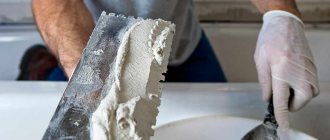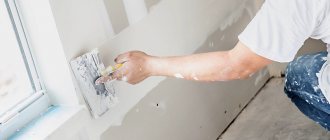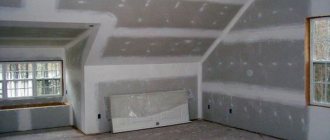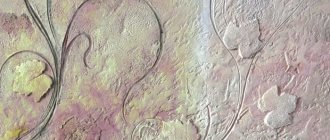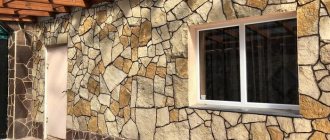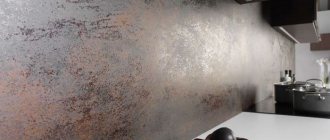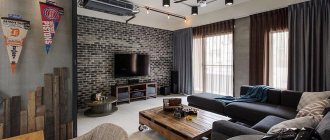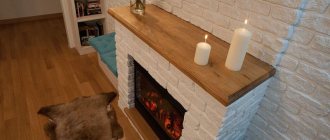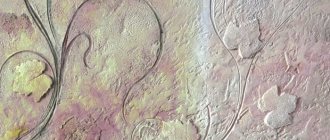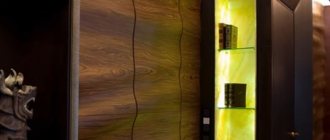Material characteristics
Material consumption
First of all, the condition of the wall affects the amount of mortar. But the standard calculation looks like this: for 1 m2 with a standard layer thickness of 1 centimeter of plaster, from 7.5 to 9 kilograms of the mixture will be required. But this is not a final calculation, because many factors can affect it. On many forums there are reviews about Volma plaster, which talk about its consumption and properties.
But it’s better to take a small supply of material so as not to have to make a second trip to the store.
The mixture also includes “Aquaslayer” plaster, which is distinguished by its fibrous composition and natural components. It is also designed to level the surface.
This type of mixture is resistant to moisture, so it can be used in rooms with high humidity; it can be used not only for interior decoration, but also for facade decoration.
The composition contains a cement component, which is excellent as a base for tiles or decoration.
Aqualayer plaster can be used everywhere, starting with concrete floors and ending with wooden walls.
This mixture is packaged in bags weighing 25 kilograms.
Price range.
Plaster is sold at construction markets and stores. Since this product is popular, it is always in stock at the warehouse. The cost of Volma plaster on gypsum is approximately 350 rubles. If you order online, the cost may be lower; only in this case, you can pay for delivery.
Nowadays there is a very large selection of finishing products on the building materials market. Many buyers are lost among the huge variety, but still give preference to the two main brands “Volma” and “Knauf”. To understand which of the building mixtures is better, you need to read reviews from both ordinary users and professional finishers, and only then make your choice.
In appearance, Volma “Layer” plaster is a white mixture in powder form, where the gypsum base is the main binder. In addition, the plaster contains polymer fillers that have a positive effect on the adhesive properties of the diluted solution.
Moisture resistance and impact resistance also increase. The properties imparted by special components begin to work when the mixture is diluted and continue to work during its further use.
Application process
The process of applying the gypsum mixture must be preceded by a preparatory stage. It will increase the strength of the composition and achieve an ideal result.
Surface preparation
If the room temperature is below the required minimum, then it is necessary to raise it using heat guns and maintain it throughout the entire finishing period. The walls are inspected and cleaned of dirt and mortar residues. All protruding and interfering objects are removed. First of all, the wall is coated with an antiseptic compound that prevents the growth of mold. After this, a primer is applied. It is necessary to ensure that moisture does not quickly leave the gypsum base, and it also additionally strengthens the surface. Porous blocks will require several coats of primer. Between each application, you must wait for the previous one to dry.
Note! If there are metal components that cannot be removed, they must be coated with an anti-corrosion compound. If this is not done, then the moisture that will pass through the gypsum base will destroy the metal, and rust will eventually appear on the surface of the wall.
Preparing the mixture
Before you open a bag of dry plaster, you need to prepare a bucket of clean water. It is worth proceeding from the calculation of 0.5 liters for every kilogram of the mixture. In some cases, the amount of water can be increased to 0.7 liters. It is worth pouring the gypsum base into water, and not pouring water into the plaster. This will cause part of the composition to rise into the air. It should be poured gradually to prevent the formation of lumps. After this, the gypsum base must be mixed well. This can be done manually, but it will take a lot of time, so construction mixers are more often used. It is worth mixing the composition by changing the direction and lifting the dry mixture from the bottom. When the mixture has reached the state of thick sour cream, it needs to brew for three minutes. After this, final mixing is done and the mixture is ready for use.
How to apply
After the gypsum base has infused, you can begin to use it. The composition is applied to the wall, starting from the bottom. The gypsum base is laid on top of the ceiling. A layer thickness of up to 8 cm is allowed if it is necessary to eliminate a strong blockage. If a layer exceeding 2 cm in thickness is applied to the ceiling, it is worth first securing the reinforcing mesh. It will strengthen the base layer and prevent it from falling off under its own weight. It is more convenient to apply plaster along the beacons. After this, it is pulled together with shaking movements using the rule. When setting begins, it is necessary to remove excess gypsum mixture and fill the resulting cavities. Marks from the rule are smoothed out with a spatula. The process of applying plaster can be seen in the video below.
Note! Tiles can be laid on gypsum plaster only after complete drying. In addition, it is necessary to prepare the surface using a primer, which will reduce porosity and increase the life of the tile adhesive.
Before finishing
After drying, the gypsum base is not yet ready for finishing, so it must be properly prepared. After the above steps, you need to check the plaster for elasticity. To do this, just press it with your finger. If the dent does not remain, then you can moisten the surface with water. You can use spray bottles for this. The next step is to grout using a special sponge trowel. After rubbing the gypsum base, it must be covered with gypsum milk. Part of the base is diluted with a large amount of water until a milky white composition is obtained. A spatula is perfect for application. After drying, it is necessary to repeat the grouting and once again moisten the wall with gypsum milk. This process is called glossing and is required in cases where wallpapering is planned. If you plan to lay tiles, then this procedure is not necessary.
Note! The consumption of gypsum plaster will depend on the method of application, as well as on the applied layer.
Reviews
“I chose Volma because I get great pleasure from working with it. The plaster adheres well and is easy to achieve the required consistency. With proper preparation of the walls, the gypsum base holds up well. According to the manufacturer, no putty is required. But if you consider that plaster is a rough coating, then putty will still be needed.”
Solomon, Moscow
“We recently moved into an old apartment. There is no need to talk about high-quality wall finishing. They were covered with lime whitewash with added dye. An attempt to paste wallpaper on top ended with it falling off after a week. My husband decided to try Volma gypsum plaster to repair cracks and dents in the wall. It stuck firmly, so they wanted to cover the walls with it and put wallpaper on top. The latter were purchased with a thick textured pattern to hide the imperfections of the walls. Everything has been holding up for a year now and there are no hints of flaws.”
Yulia, Saratov
“For a long time we couldn’t decide to renovate the apartment. This is due to the fact that it can only just begin. Having saved enough money, the first thing I wanted to do was remove the walls. On the advice of the craftsmen, we purchased Volma-Sloy gypsum plaster. It didn’t take long to choose, because the reviews about it were positive. We purchased as many as 25 bags weighed at 30 kg. This is exactly how much it took to level our walls in the old house. The old plaster was knocked down to concrete and Volma was applied. We are happy with the result, and working with plaster brought only positive impressions.”
Margarita, Vologda
Instructions for dilution and application.
The preparation of Volma “Layer” gypsum plaster begins with studying the instructions. Here are essentially the usual steps; it is important to follow the proportions indicated on the packaging. To 1 kilogram of the composition add 600-700 milliliters of liquid. Considering that Volma gypsum plaster is packaged in 30 kg craft bags, it turns out that we need 18-21 liters of water per package.
To begin, pour some water into a convenient container (preferably plastic, it’s easier to work with) to wet the bottom and walls. The mixture is poured to the exact ratio of water according to the proportions. Mixing can be done using a trowel or trowel, but it is much more convenient (much easier for large volumes) to use a construction mixer or a trill with a special attachment. Tools will significantly save time and effort for quality work.
After stirring once, let the solution sit for about 3-5 minutes, this is the period of maturation of the components. After time has passed, stir the diluted mixture again until lumps are completely removed. The consistency should resemble thick sour cream, be plastic, but at the same time not flow off the instrument.
The gypsum composition in question can be used for minor repairs and major interior finishing. The limitation is due to the fact that gypsum, by its nature, absorbs moisture very well, so applying such plaster outdoors is a bad option.
The diluted composition is excellent for: plastering plasterboard, cellular concrete, reinforced concrete slabs, brick and wood.
This plaster is used for:
- restoration work, when minor defects are eliminated;
- minor repairs to level surfaces;
- capital finishing, when work is done from scratch;
- as a finishing coating for leveling before grouting with a sponge float
- creating decorative elements, arches, reliefs or sculptures.
After applying the finishing coat, immediately begin painting or laying ceramic tiles; surfaces coated with Volma “Layer” plaster allow this to be done.
Remember the recommendations on the packaging; the work room should be dry with a temperature range of 5-30 degrees above zero.
Note: If Volma gypsum plaster is applied in rooms with high humidity, then treat it with protective compounds. Do not allow water to come into direct contact with the plaster.
Brief instructions for Volma Layer plaster
If you come across “VOLMA-SLOY” plaster, there is only one instruction - you have to take it! No kidding. In terms of the “price-quality” parameter, it has earned approval from the community of plasterers and painters, which is confirmed by reviews in thematic forums.
Even a cave needs comfort
The word plaster came to us from Italy, where it is pronounced with a rolling stuccatura, as a derivative of stucco, which translates as “lime, gypsum, alabaster” - materials that have been used for wall decoration since ancient times. And in our time, they are the main component of mixtures, without which no room renovation can be done. Plaster hides wall defects and makes the surface pleasing to the eye and hand. It creates the coziness necessary in both residential and industrial premises.
In the same row is VOLMA plaster, in the line of its modifications there are a dozen items. Why so much? For the convenience of consumers. The variety of surfaces requiring finishing involves a wide range of materials. Among them is the VOLMA-SLAY mixture. And it's not even about variety, but about quality. After working with VOLMA gypsum plaster, the finisher professionally feels that the choice is correct. That is why the entire line of these products holds second place in the oversaturated market of gypsum plasters in Russia.
Gypsum has another attractive force. Its virgin whiteness. The surface on which the VOLMA-LAYER layer is carefully smoothed does not require whitewashing, and at the same time it is suitable for any painting. With VOLMA gypsum plaster, a creative finisher will show all his abilities.
We study the parameters and prepare for application
Gypsum plaster “VOLMA-SLOY” is packaged in bags weighing 5 kg, 15 kg, 25 kg, 30 kg. It is intended for manual application, does not require puttying and has the following parameters.
| Consumption per 10 mm layer thickness | 8-9 kg per 1 sq.m |
| Recommended layer | 5-30 mm |
| Maximum layer | 60 mm |
| Drying time for 10 mm layer | 5-7 days |
| Specific amount of water not per unit weight | 0.6-0.65 l/kg |
| Operating temperature during application | from +5 to +30°С |
| Setting period | no earlier than 45 minutes |
| End of setting | no later than 180 minutes |
| Compressive Strength | not less than 3.5 MPa |
| Flexural strength | not less than 1.5 MPa |
Detailed instructions for "VOLMA-SLAY" in accordance with the requirements of Rospotrebnadzor are printed on each bag. In general, it is typical for gypsum mixtures
Surface preparation includes the following steps:
- clean from grease, dirt and dust;
- metal elements are coated with anti-corrosion paint;
- Level the surface and impregnate it with primer.
The required material is calculated as follows:
- based on the labor force, the area in m2 is determined, which will be plastered in 2.5 hours;
- multiplied by 8.5;
- select the required quantity and prepare the batch.
Dilution of the VOLMA-SLAY mixture is carried out as follows:
- take a clean plastic container;
- water at room temperature is poured into it at the rate of 0.6 liters per 1 kg;
- covered with gypsum mixture;
- mix thoroughly with a construction mixer until a homogeneous mass is obtained;
- settles for several minutes.
Application and trimming is done as follows:
- apply a layer of 5-60 mm with a trowel;
- aligned by rule;
- after setting and drying, the surface is kept for 40-60 minutes;
- if required, trimmed with a rule.
Correctly applied VOLMA, a layer of plaster, does not require putty, but when graininess appears, it is rubbed with a sponge grater, generously moistened with water. Having made sure that a matte surface has been obtained, proceed to the next stage, when the plaster can be smoothed with a wide metal spatula.
All that remains is to dry the plaster, which will take up to 7 days. Flowing ventilation with warm air will speed up the process. The surface is ready for subsequent finishing. It can be painted, wallpapered, decorated with a pattern or texture. If necessary, apply a second coat.
Safety and storage
When working with the VOLMA-SLAY mixture, you should use the following personal protective equipment:
- headdress;
- glasses;
- respirator;
- gloves.
Please remember that dust particles can cause an allergic reaction.
The mixture is diluted in a clean container, and a clean tool is used to apply the solution. Unclean containers and contaminated tools reduce the time of application of diluted plaster. After use, tools and containers are thoroughly washed with water.
Bags of VOLMA-Sloy plaster mixture are stored on wooden pallets in dry rooms. If the bags are damaged, the mixture is poured into whole bags to be used first.
The manufacturer guarantees 12 months of storage without loss of quality in undamaged original packaging.
Preparing the wall.
You must first prepare the base for applying Volma plaster, otherwise you will get a bad result.
- Remove dust and dirt.
- Remove any remaining paint and loose pieces of plaster.
- Smooth out cracks and chips.
- Check the evenness of the wall with a level.
- If necessary, install leveling beacon profiles.
- Treat metal objects that are part of the base with an anti-corrosion agent.
Volma “Layer” gypsum plaster is applied to the bases manually using a standard set of tools:
- Different sized spatulas.
- Trowels made of different materials.
- Rule and falcon.
- Leveling floats.
The instructions indicate how to use Volma plaster with the listed tools. It is not worth diluting a lot of gypsum mixture at once, since the hardening period of the gypsum is 20-30 minutes. Calculate how much area you will have time to process during this time and, based on the consumption of Volma “Layer” plaster per 1 m2, mix the solution.
Preparing the walls
Before the Volma gypsum plaster is prepared, it is necessary to prepare the walls to achieve the best effect.
First of all, it is necessary to clean the walls from existing dirt and dust. After this, you need to remove the old layer of plaster or wallpaper from the wall. Treat existing surface irregularities, remove cracks and chips. Level the walls with a level, using a beacon profile if necessary. If there are metal parts at the base of the wall, they must be treated with a special anti-corrosion agent.
Volma Layer plaster is applied only by hand, using:
- spatulas of various sizes;
- various trowels;
- falcons and rules;
- leveling floats.
The instructions for the plaster describe in detail not only how to prepare the solution, but also what tools to use. When preparing the solution, it is worth considering that the hardening time of the gypsum varies from 20 to 30 minutes, so you should not apply a lot of the mixture. Before diluting the composition, you need to calculate the area of the surface to be treated, taking into account the processing time, and only then dilute the plaster.
Application sequence.
Leveling - having thrown the composition onto the wall, they begin to level it using a broad rule using beacons or without them when the wall is more or less even). The rule is from bottom to top, removing all excess and placing it on the recesses.
Trimming is carried out when the gypsum structure has set (after an hour) and acquired hardness. Similar to leveling, the rule cuts off small irregularities in individual areas, directing them into the remaining recesses. Already at this stage you can finish with plaster if your goal is to decorate with wallpaper or tiles. Remember to prime the surface before proceeding with the next type of work.
Decor on the surface.
You can decorate in different ways, from simple wallpapering to complex techniques of painting on dry plaster. It all depends on your preferences.
- The relief and texture can be set by special rollers. You can also even apply a relief pattern that can be selected on the roller rotor.
- The texture is also set with a simple spatula, alternately pressing on the weakly set gypsum solution. It turns out very beautiful.
- Decorative plaster can make many dreams come true, having a huge selection of options.
- Having the talent of an artist, take up your brushes and paints, create unique and inimitable patterns.
Important! Proceeding to the next stage after applying the plaster, be it wallpaper or tiles. Be sure to saturate the surface with primer, otherwise all your work will go down the drain. The primer will increase the adhesion of surfaces.
Specifications.
The diluted composition has:
- excellent adhesion;
- excellent vapor permeability, which affects air movement in the room;
- environmental friendliness - the basis is natural gypsum;
- no shrinkage.
The presence of good technical characteristics in Volma gypsum plaster has a positive effect on quality. Distinctive characteristics:
- working thickness from 5 to 30 millimeters;
- completion of setting within 3-4 hours;
- complete hardening within a week.
Undoubtedly, everyone has noticed that applying Volma Layer plaster to walls is very simple; you can do it yourself without resorting to the services of repair crews. This will significantly save your budget.
How to breed Volma layer
To dilute 30 kg of dry Volma layer powder, the instructions for use recommend taking 18-19 liters of cold tap water. The water consumption indicated is approximate. Therefore, the consistency of the solution will have to be adjusted to the desired consistency during mixing.
This is due to several factors, for example, to apply the mass in a thick layer, you need a thick consistency. Therefore, to begin with, not the entire specified volume is poured into the container, leaving 3-4 liters separately for finishing (in reserve). If, when mixing, the gypsum plaster turns out to be thick, add liquid from the reserve, adding in portions.
When mixing a smaller mass, the volume specified by the manufacturer is proportionally reduced and a portion is also left in reserve. So for 10 kg of mixture take 6-6.3 liters. The volume of water poured into the container should not occupy more than a third of its volume, otherwise part of the solution will end up on the floor.
A simple rule that is easy to remember: it is correct to pour powder into water, but do not pour liquid into the dry mixture.
Be sure to take cold water. Increasing the temperature of the mixing water dramatically increases the rate of all chemical reactions. Therefore, the lifespan of the solution is reduced, which is undesirable.
Mix the water and powder with a mixer at low speed. Using a spatula or trowel, remove the adhering debris from the walls of the container towards the center and discard it. Stir again until the lumps disappear.
A feature of the process of mixing and hardening of the gypsum composition is its ability to become a “stake” when lumps of old mortar enter. In a fresh solution during the normal course of the process, crystallization centers do not appear immediately, only at a certain stage.
But lumps of previously mixed gypsum already have such centers, therefore, in turn, when they get into a fresh solution (at any stage), they become catalysts for the formation of new centers and serve as them themselves.
For the same reason, you cannot add gypsum powder to the thickening solution. If you want to regulate the consistency, then it is better to dilute the initially thick mixture when mixing, adjusting the density with a water supply.
After the first mixing, the solution is allowed to stand for 3-4 minutes and mixed again. After this, the mass can be applied to the wall.
Plaster consumption.
Of course, material consumption depends on the curvature of the wall and the thickness of the layer. But, by default, based on the consumption of Volma plaster per 1 m2 with a layer thickness of 1 cm, you will need about 7.5 -9 kilograms.
It is not at all necessary to rely and take this as a basis, because there can be many factors influencing consumption. In order to avoid the mistakes of others, spend a little time on forums about Volma plaster where there are probably reviews about working with it.
Recommendation: Volma “Layer” gypsum plaster is purchased with a small reserve; this action will protect you in future from going to the store again when you are faced with minor surface modifications.
General description and properties
Volma Layer is gypsum plaster, which means that the main part of the mixture is gypsum, and the rest is various additives that improve its properties. For example, plasticity, the ability to adhere well to various substrates and not set for a long time. Most manufacturers keep secret both the types of such additives and the exact recipe for making plaster, indicating only general information on the packaging.
Gypsum plaster is a powder, the color of which depends on the shade of natural gypsum, mined in different quarries and having various impurities. It can be white, gray, with a greenish or even pinkish tint. This does not affect the quality of the product in any way.
Volma Layer has a lower consumption than pure gypsum due to its greater plasticity and prolonged setting time - it is easier to “stretch” it over the surface in an even and as thin layer as possible. Although the main advantages of the product include the ability to apply a fairly large layer up to 60 mm thick without the need for reinforcement.
When leveling with cement plaster, such a thick layer must be reinforced with mesh Source evro-lshop61.ru
For reference! The retarding additives included in the dry mixture allow the ready-made solution to be used within 1-2 hours from the moment it is mixed, while “pure” gypsum sets within 20-25 minutes.
One of the significant properties of all gypsum compositions is their ability to actively absorb water and moisture from the air. In this case, the coating swells, becomes loose and heavy, and can peel off from the surface. Therefore, they are used mainly for interior work.
On the facade of a house, gypsum plaster does not hold up well without a reliable protective coating Source hotgeo.ru
See also: Catalog of companies that specialize in finishing materials and related work
Other mixtures from the manufacturer.
Volma “Aquaslayer” plaster is a lighter fibrous composition with the presence of Portland cement, polymers and natural components. Like the composition we are considering, it is intended for leveling bases. Already from the name one can judge that it is hydrophobic and can be used in wet areas. Cement plaster Volma "Aquasloy" is used both inside buildings and on their exterior facade.
Compositions with a cement binder are often used as a primary layer, which serves as a reliable base:
There are practically no restrictions on covering bases with Aqualayer; it can be cellular concrete, reinforced concrete products, floor slabs, wooden walls. Volma cement plaster “Aquaslayer” is packaged in 25 kg craft bags.
Conclusions and comparisons.
Today, putty is a universal material with a lot of possibilities. A variety of compounds are used for surface treatment, leveling walls, and sealing joints. Without the use of this consumable, it is impossible to carry out a full overhaul. The putty presented on the modern market differs not only in the components in its composition.
The material has individual technical characteristics and other features. Among the huge variety of assortments, Volma putty is very popular. The products of this brand have gained popularity due to a number of advantages.
General characteristics
Putty is used to level walls and ceilings. The material is necessary to prepare the surface for applying paint, wallpapering, laying tiles or whitewashing. The company's catalog presents two types of products of different consistency - ready-made liquid and dry mixture.
| Name | Type of mixture | Price |
| Volma-Cream | Finished, ready for use | 4 kg – 800 rub. |
| Volma-Shov | For sealing seams and joints, dry powder | 25 kg – 275 rub. |
| Volma-Satin | For leveling walls and ceilings, dry powder | 20 kg – 230 rub. |
| Volma-Standard | Basic leveling of walls and ceilings, dry powder | 25 kg – 360 rub. |
| Volma-Aquastandard | Basic white cement based, reinforced, dry powder | 22 kg – 240 rub. |
The diluted material (liquid composition) is sold in plastic buckets of different volumes. The main advantage of such a product is that it can be used immediately after purchase, without prior preparation. This option contains components that prevent the mixture from hardening quickly. The price of this option is slightly higher than traditional ones.
As for bulk products, they are packaged in durable bags weighing from 3 to 25 kg. Here you can choose the degree of density yourself, depending on the quality of the walls and the accuracy of the vertical. Before diluting the putty, you need to determine the initial volume of liquid for a certain amount of dry powder. The solution is prepared quickly - just dilute everything with liquid and mix thoroughly with a mixer. Dry material is easy to transport and store; you just need to maintain the temperature and humidity recommended by the manufacturer.
In addition, the range is divided into categories according to the main component in the composition. Building materials are:
- latex;
- cement;
- plaster;
- polymer;
- acrylic.
The choice depends entirely on the type of subsequent work.
Peculiarities
The putty of the above brand is made on a natural gypsum base. This is the main component that plays an important role in the final result. Gypsum has a high viscosity, reliably connecting other elements. On store shelves and in the brand’s catalogue, the products are presented in dry form. This putty is used for manual repair work.
Additional components of the compositions are chemical and mineral trace elements. Additives are responsible for various performance characteristics, including wear resistance and adhesion.
Advantages
Having analyzed the products of the Volma brand, experts came up with a number of advantages. The positive aspects of the product were confirmed by professional craftsmen and ordinary buyers.
- The mixture has elasticity and plasticity. This is a light, airy composition.
- Volma putty is an environmentally friendly and healthy material.
- This material has no shrinkage.
- This putty is characterized by thermoregulation.
- It is easy to use and of high quality.
- With its help, effective leveling is possible, as well as reliable sealing of seams.
- The maximum layer of material (in the process of leveling the base with one layer) is about 6 cm.
We have outlined the main advantages of the choice. Only certified, original products have the above advantages.
Range
A whole range of putty compositions are manufactured under the Volma brand. Let's pay attention to the most popular and widely used positions.
"Aquastandard"
This product is based on a cement base, or more precisely Portland cement. A distinctive feature of this putty is reinforced fibers, which provide excellent reliability, strength and wear resistance. The Aquastandard product boasts increased resistance to moisture and non-shrinkage.
The technical data are as follows:
- material color – gray;
- the optimal temperature for work is from +5 to +30 degrees;
- maximum layer of putty – 8 mm;
- The minimum drying period is one day. Maximum – 36 hours.
- the middle layer varies from 1 to 3 mm;
- After dilution, the composition must be used within two hours.
- For 1 kg of composition you need to spend about 0.3 liters of liquid.
Instructions
To thin gypsum plaster, use only clean plastic buckets or other containers. It is not recommended to dilute in metal containers. First, water is added at the rate of 600-650 ml per 1 kg of mixture, and then the gypsum plaster itself. Then knead until smooth using a drill or mixer. If the desired consistency is not achieved, add water or gypsum plaster as needed. After mixing, the gypsum plaster mixture should sit for two to three minutes. After this time, you can begin application.
Expert advice
Before purchasing putty, accurately calculate the amount of material required. It is recommended to buy it with a reserve if you are working with such a finishing material for the first time and do not have the proper experience. Standard packaging weighs 25 kg. Review the quality certificates before purchasing. Relevant documentation confirms the quality of the product.
When purchasing, look at the expiration date of the composition: after it expires, the material loses its properties. In addition, buy products based on the type of surface.
Advantages and disadvantages
It is important to be well aware of the pitfalls of any material or device before use. Regarding the gypsum base, the following advantages can be highlighted:
- no shrinkage;
- ease of application;
- environmental friendliness;
- no need for putty;
- vapor permeability;
- no need for pre-plastering.
When dried, the gypsum base from Volm does not shrink. This is what makes it possible to immediately apply a thick layer of plaster. Applying plaster to walls does not require the use of special tools. It is enough to use a trowel or ladle. It is easy to pull together, because the solution is plastic. The surface of the dried Volma gypsum mixture is glossy, so it does not need to be additionally covered with plaster for finishing. Walls require a minimal level of preparation before application, so there is no need to plaster them before applying Volma. Thanks to its components, the plaster is environmentally friendly and has no harmful emissions. Due to the presence of pores, the material allows the walls to carry out gas exchange, which prevents the development of fungus and mold.
Reviews
The network has collected a huge number of opinions from professional craftsmen from the repair industry and ordinary buyers. Users note that purchasing putty from the above brand is a smart purchase. Most reviews are positive. Users focused on the excellent results, reliability and practicality of these compositions.
In the video below, watch the process of applying Volma Layer gypsum plaster.
Varieties of Volma plaster
The manufacturer's assortment includes a whole line of gypsum bases. "Volma-Lay" is a standard plastering mixture that does not require the use of putty. "Volma-Canvas" is an excellent option for finishing large areas. This plaster has more plasticizers, which extend the life of the solution. "Volma-Plast" is perfect for finishing ceilings and walls. This is a lightweight plaster that is applied by hand. If it is preferable to use machine application of plaster, then it is better to use “VOLMA-Gips-Active Extra”. Its consistency makes it perfect for automated use.
